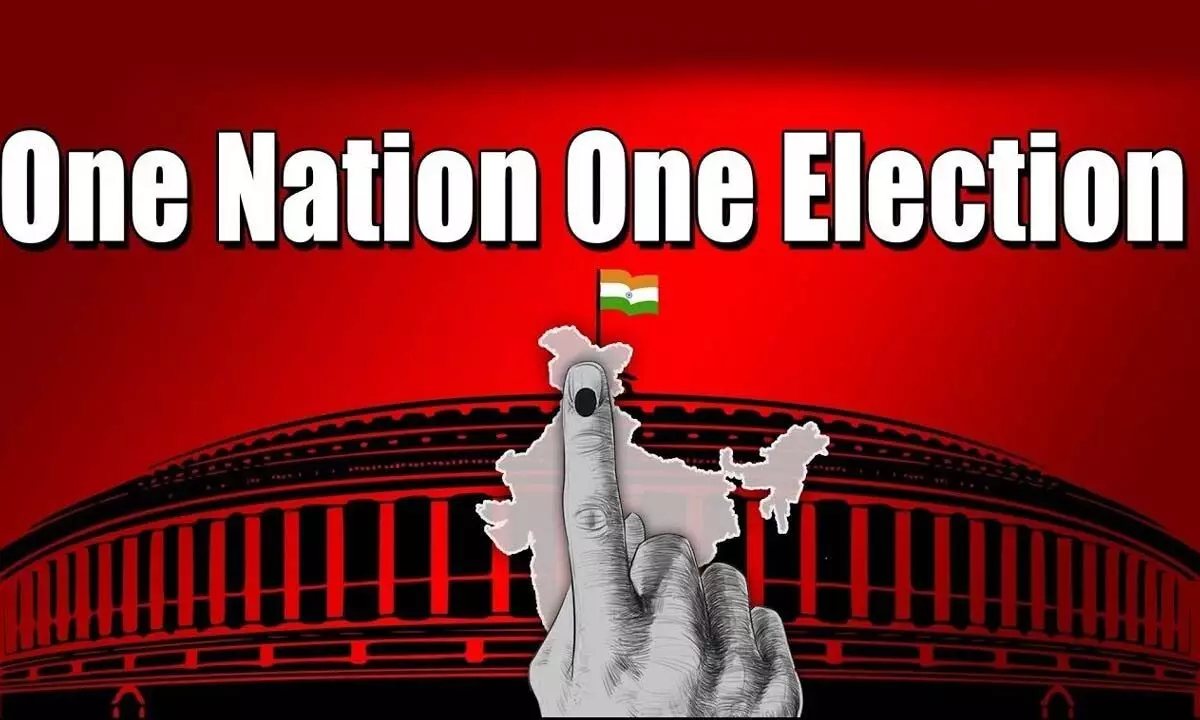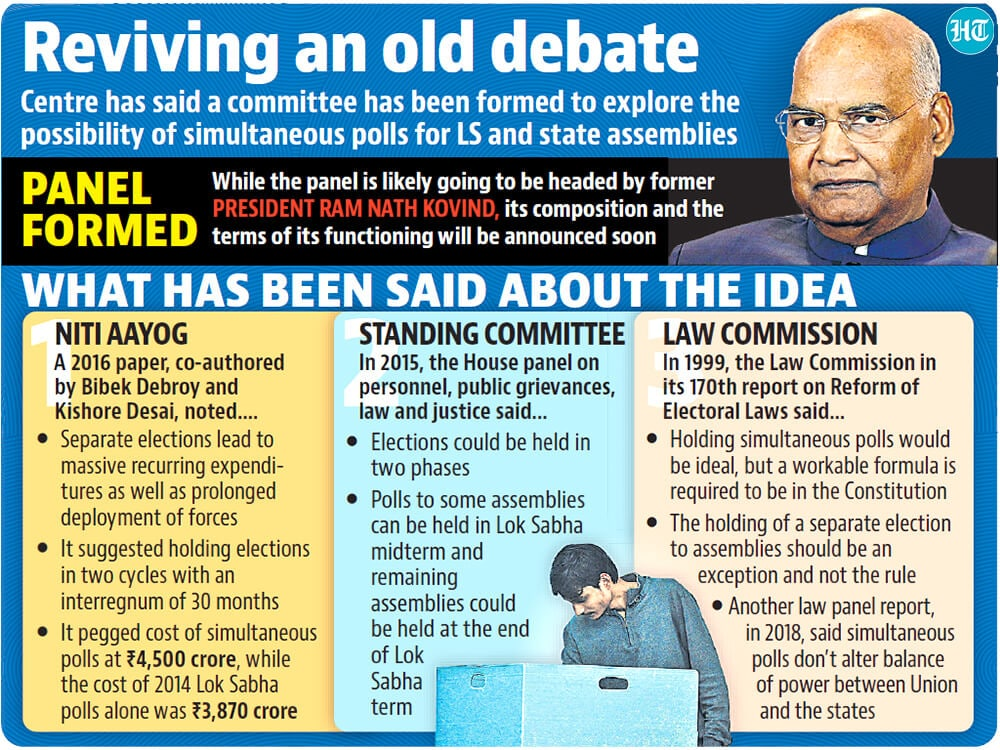Description

Copyright infringement not intended
Picture Courtesy: www.thehansindia.com
Context: The Union government established a committee led by former President of India Ram Nath Kovind to examine the feasibility of simultaneous elections in the country. The committee includes prominent members such as Union Home Minister Amit Shah, former Leader of Opposition in the Rajya Sabha Ghulam Nabi Azad, and others.
Key Highlights
- The committee will explore the concept of "one nation, one election" and make recommendations for holding simultaneous elections to State Assemblies and the Lok Sabha.
- Terms of Reference for the Committee: The Law Ministry has provided seven terms of reference for the committee. One of these terms of reference is to examine and recommend whether constitutional amendments are required to enable simultaneous elections and if these amendments necessitate ratification by the States.
- The Indian Constitution was designed to be adaptable to changing circumstances. Article 368 of the Constitution governs the process of amending it. Amendments can be made through three different procedures:
- Simple Majority: Some provisions can be amended in the same way as ordinary legislation, with a simple majority of those present and voting in each house of Parliament.
- Special Majority: For amendments not falling under the first category, a 'special majority' is required, which means a two-thirds majority of the members present and voting in each house and a majority of the total membership of each house.
- Ratification by States: A third category of amendments demands a 'special majority' in Parliament and ratification by at least one-half of the State legislatures. While there's no specific time limit for ratification, resolutions must be passed by State legislatures before the amending bill is presented to the President for assent.
- Provisions Requiring Ratification by States: These provisions, known as 'entrenched provisions,' pertain to the federal structure of the Constitution. They include changes related to presidential elections, the distribution of powers between the Union and States, alterations to the Lists in the Seventh Schedule, changes in the representation of States in Parliament, and amendments to Article 368 itself.
- Time Limit for Ratification: Unlike the U.S. Constitution, the Indian Constitution doesn't specify a time limit for ratification. The U.S. Supreme Court has ruled that ratification should occur within a 'reasonable time,' a matter that may depend on social, political, and economic factors.
- Law Commission's Report: In 2018, the Law Commission of India, issued a report suggesting that simultaneous elections would require constitutional amendments and the consent of at least 50% of states. However, implementing these recommendations without infringing on the federal structure is a challenge.

Picture Courtesy: www.hindustantimes.com
Simultaneous polls
About
- Simultaneous polls, also known as "One Nation, One Election," refer to the practice of holding elections for the Lok Sabha (the lower house of India's Parliament) and all state legislative assemblies at the same time, rather than at different intervals as is the current practice.
- Simultaneous polls have been a topic of discussion in India for several decades. The primary motivation behind this idea is to reduce the frequency of elections, which can be resource-intensive and often disrupt governance. The idea gained prominence in recent years due to the perception that frequent elections lead to policy paralysis and increased expenditure.
- The Indian Constitution does not explicitly mention simultaneous elections. Currently, elections to the Lok Sabha and state legislative assemblies are held separately and are subject to the provisions of the Representation of the People Act, 1951.
Significances
Reduced Expenditure
- Financial Savings: Conducting elections is an expensive affair. There are costs associated with organizing polling stations, deploying security personnel, printing ballot papers, and conducting voter awareness campaigns. By holding multiple elections simultaneously, these costs can be significantly reduced. Fewer election cycles mean less expenditures on the logistics and administration of the electoral process.
- Resource Optimization: Simultaneous elections also optimize the use of government resources. For instance, government employees and security forces can be utilized more efficiently when they are involved in election-related duties for a shorter duration.

Stability
- Political Stability: Simultaneous elections can contribute to political stability. In many democracies, frequent elections can lead to a state of perpetual campaign mode, where political parties are constantly focused on election strategies rather than governing effectively. This can lead to policy paralysis and governance challenges. Fixed, synchronized election cycles can mitigate this issue, allowing governments to focus on policymaking and governance without the distraction of impending elections.
- Reduced Mid-term Elections: In countries with multiple levels of government (e.g., local, state, and national), staggered election cycles can result in mid-term elections that disrupt the political landscape. These mid-term elections can be costly and may lead to frequent changes in government. Simultaneous elections reduce the likelihood of mid-term polls, providing more stability and allowing elected officials to complete their full terms.
Enhanced Governance
- Policy Implementation: Frequent elections can impede the long-term planning and implementation of policies and projects. Elected officials may hesitate to make tough decisions that could impact their electoral prospects. Simultaneous elections, by providing a stable tenure, allow governments to undertake reforms and policy initiatives that may not yield immediate electoral benefits but are in the long-term interest of the nation.
- Administrative Efficiency: Simultaneous elections also streamline the administrative process. Government machinery can be better utilized when elections are held concurrently. Public servants are not constantly transitioning between election-related duties and regular administrative work, which can lead to more efficient governance.
Challenges associated with implementing simultaneous elections
Constitutional Amendments
- Altering State Assembly Terms: To implement simultaneous elections, the terms of state legislative assemblies and the Lok Sabha (the lower house of India's Parliament) would need to be synchronized. Currently, state assemblies have different terms, and this would require amending various provisions of the Constitution, including Article 83 (dealing with the duration of the Lok Sabha) and Article 172 (dealing with the duration of state legislative assemblies).
- Legal and Procedural Changes: Apart from altering the terms, various other constitutional provisions and laws would need to be amended to facilitate simultaneous elections. This includes changes in the representation of states in the Rajya Sabha (the upper house of Parliament) and electoral laws governing the conduct of elections.
Logistical Challenges
- Geographical Diversity: India is geographically diverse, with varying levels of development, infrastructure, and accessibility. Conducting elections simultaneously across this vast country poses significant logistical challenges, including setting up polling booths, transporting election materials, and ensuring the security of voters and polling personnel.
- Resource Allocation: Simultaneous elections would require a substantial increase in resources, such as electronic voting machines, security personnel, and election officials. Allocating these resources efficiently and equitably across all constituencies can be a daunting task.
Political Consensus
- Diverse Political Landscape: India has a multi-party political system with various parties representing different regions, ideologies, and interests. Convincing all political parties to agree on the idea of simultaneous elections is a formidable challenge, as each party may have its calculations and reservations.
- Fear of Dominance: Some smaller or regional parties may fear that simultaneous elections could lead to the dominance of national parties, potentially marginalizing their representation in state assemblies or the Lok Sabha.
- Constitutional Amendments: The process of amending the Constitution requires a two-thirds majority in both houses of Parliament, which necessitates political consensus. Gaining such consensus can be challenging when parties have differing priorities and agendas.
Way forward
- Continue Dialogue: Continuing discussions with all stakeholders is a critical first step in any decision-making process. It allows for the exchange of ideas, concerns, and perspectives from different parties involved. Seeking consensus is important for building broad-based support for any major policy change.
- Constitutional Amendments: If consensus is reached through dialogue, pursuing necessary constitutional amendments is a logical next step. In many countries, the timing and frequency of elections are enshrined in the constitution. Changing this would require formal legal changes, and it's a complex process that often requires a supermajority or other specific conditions.
- Pilot Projects: Implementing simultaneous elections on a pilot basis in a few states or regions can be a practical approach to assess the feasibility and address any challenges that may arise. Pilot projects allow for real-world testing and can provide valuable data and insights before full-scale implementation.

Conclusion
- The issue of simultaneous elections in India involves complex constitutional considerations and practical challenges. Balancing the desire for synchronized elections with the federal structure of the Constitution is a complex task that requires careful deliberation and cooperation between the central government and states.
Must Read Articles:
COMMITTEE ON SIMULTANEOUS ELECTIONS: https://www.iasgyan.in/daily-current-affairs/committee-on-simultaneous-elections
|
PRACTICE QUESTION
Q. Considering the complex nature of implementing simultaneous elections in India, how can the government effectively navigate the challenges related to constitutional amendments, logistical issues, and political consensus in order to achieve the goal of "One Nation, One Election"?
|
https://epaper.thehindu.com/ccidist-ws/th/th_delhi/issues/52440/OPS/G6HBP6A04.1.png?cropFromPage=true











